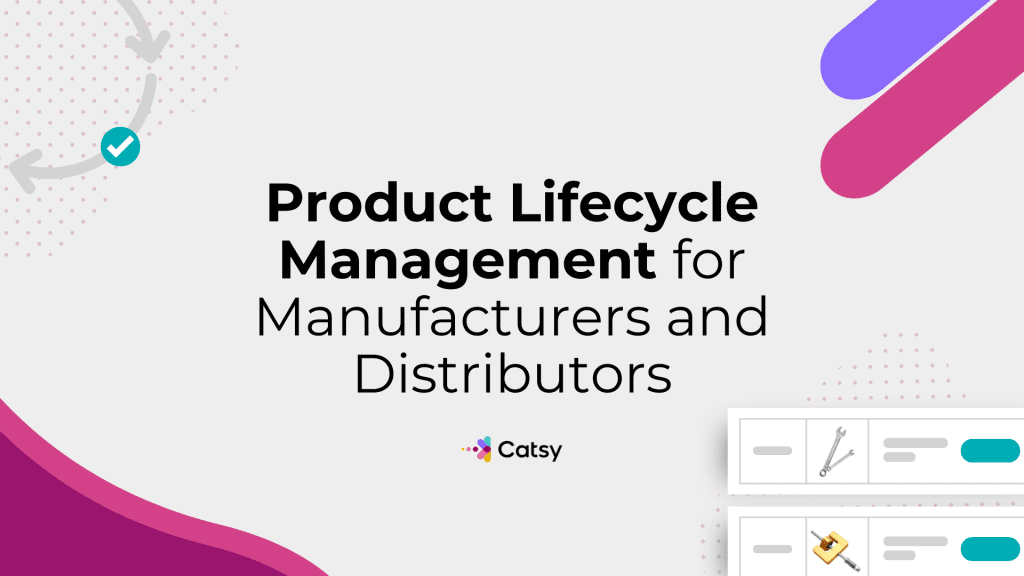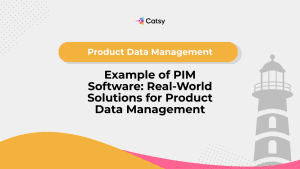Product Lifecycle Management for Manufacturers and Distributors
Product Lifecycle Management for Manufacturers and Distributors: For many mid-sized manufacturers and B2B brands, managing product data is a daily juggling act. Often engineering specs are in one system, marketing copy in another, and packaging details buried in email threads. And as product lines expand, keeping everything aligned—especially when distributors are asking for clean, consistent data—gets harder fast.
Product Lifecycle Management (PLM) can help with that.

The Guide: Product Lifecycle Management for Manufacturers and Distributors
PLM serves as a framework for overseeing all aspects of a product, from the initial design stage through to its final retirement – also referred to as “Cradle” to “Grave”. It gives your company’s often-overlooked areas structure, accountability, and visibility.
💡In this article we’ll talk about:
- The true nature of PLM
- Its importance and role in simplifying processes around a product’s lifecycle
- Its relationships to e-commerce syndication,distributor networks, and product data workflows
- The functions of platforms such as DAM and PIM
Knowing PLM may help you work more efficiently and avoid costly confusion and scattered data, whether you’re making industrial tools, commercial kitchen equipment, HVAC components, or personal protective equipment.
In this Article
The True Nature of Product Lifecycle Management
In other words, is the process of managing a product’s journey from concept to end-of-life. Starting from initial sketches and prototypes to final manufacturing specs, regulatory documents, and revision history.
It’s the source of truth for how your product gets built and evolves over time.
Core Functions of PLM
- Keep track of product designs, BOMs (bill of materials), and technical drawings
- Manage revisions and approvals as products change
- Ensure that engineering, sourcing, and operations teams are always working with the latest version
- Document compliance and certifications across product lines
It’s not the same as ERP (Enterprise Resource Planning), which handles financials and logistics. And it’s not quite the same as a PIM (Product Information Management) system, which is built for ecommerce and marketing data. PLM sits upstream—closer to the engineering and product development process.
Simple way to think about it:

The Role Product Lifecycle Management (PLM) Plays In Your Ecosystem
It’s used to be mostly found in engineering departments. But PLM now has a far wider function as businesses transition to digital-first operations.
It is a single component of a much bigger puzzle that also consists of:
System | What It Manages | Primary Users |
PLM (Product Lifecycle Management) | Product development, specs, revisions, documentation | Engineering, R&D, Compliance |
Channel-ready product content, specs, distributor data, digital shelf assets | Marketing, Sales, Channel Managers | |
Product images, manuals, safety sheets, videos | Creative, Marketing, Sales | |
Inventory, pricing, supply chain, customer orders, fulfillment | Operations, Finance, Procurement |
Here’s the key: these systems are only powerful if they’re connected.
If your PLM is managing spec sheets and CAD files, but your PIM has different dimensions or materials listed, that disconnect can lead to:
- Conflicting product descriptions in distributor feeds
- Incorrect SKUs in ERP systems
- Mistakes in manufacturing or packaging
- Product returns due to inaccurate specs
These issues quickly escalate, especially for companies who sell through channels like Grainger, MSC, Fastenal, or operate ecommerce sites via BigCommerce or Shopify.
Fact: Many manufacturers still rely on emailing spreadsheets between departments. And that’s ok for 10 SKUs—but definitely not for 10,000.
When your PLM hands off clean, accurate data to your PIM and ERP, it ensures consistency across the full product lifecycle—from design to distribution.
Make Catsy DAM and PIM Software an Extension of Your Team
Book a Free DemoWhat is the Cost of Poor Product Lifecycle Management Practices, then?
Many industrial brands and mid-sized manufacturers either don’t use PLM at all or use it improperly. But there’s a price for ignoring it. When PLM practices are fragmented, manual, or team-specific, it affects your entire product ecosystem.
This can lead to fragmented product knowledge, launch delays and bottlenecks, compliance issues, increased return rates, and agitated personnel in the real world.
⚠️ Without PLM Best Practices | ✅ With Streamlined PLM Workflow |
A spec (e.g., product dimensions) is manually entered into a spreadsheet… | Product specs are centrally managed from a single, validated PLM source. |
→ Packaging team gets outdated data via email. | → Specs are auto-synced to packaging systems and documentation tools. |
→ Channel marketing uses an older version for distributor catalogs. | → Marketing always pulls the latest approved specs from PIM. |
→ Sales rep quotes incorrect measurements to a distributor. | → Sales teams access up-to-date specs from a shared content hub. |
→ Distributor receives products that don’t match published specs. | → Distributors get exactly what’s listed—reducing complaints and returns. |
→ Returns increase, support tickets spike, and trust takes a hit. | → Fewer returns, smoother launches, and stronger distributor confidence. |
So, why does PLM matter for mid-sized manufacturers and distributors?
People often assume PLM is just for massive enterprises with entire departments dedicated to product development. But it is not.
If your business is designing, assembling, bundling, or customizing products, PLM principles apply to you.
In fact, for mid-sized manufacturers, B2B suppliers, and industrial distributors, the stakes are often higher:
- You have leaner teams juggling product data across engineering, marketing, and sales.
- You’re selling across multiple channels—Grainger, Fastenal, BigCommerce, and through independent reps
- Your product complexity is increasing (more SKUs, more variants, more custom orders).
- And your margin for error is smaller—one mistake in a spec sheet or delayed update can cost thousands.
You may not need a giant enterprise PLM system—but you do need a way to manage product data cleanly, from development to launch to syndication.
How Can My PLM Process Be Improved?
To support your team, you need the appropriate tools and an organized approach.
(Early) Standardization of Product Data
Describe your key attributes, including your measurements, materials, and compliance details.
Immediately establish name conventions and measurement units. Next, list the fields that are necessary for each type of product. Additionally, record new product introduction (NPI) workflows.
🔧 Tip: To minimize repetitious setup, use templates for product families.
Centralize Important Resources and Details
Keeping product specifications in one system, photos on Dropbox, and packaging documents in someone’s inbox will cause problems for your team.
By combining PIM + DAM, you may store digital assets, marketing content, certifications, and specs in one place. Tools like Catsy are helpful in this situation.
Because of this, everyone can see any modifications you make.
Align Cross-Functional Teams
Product content touches multiple departments—engineering, operations, sales, ecommerce. And yet? Most teams operate in silos.
Set up regular syncs between stakeholders (or better yet, shared tools) so handoffs are smooth and nothing falls through the cracks.
Audit and Clean Your Existing Data
Product lifecycle management enhancements won’t go very far if your current data is disorganized. Consider what you have:
- Perform a brief system-wide audit of product attributes to find any duplicates, out-of-date information, or irregular formatting.
- Recognize any missing information (weights, compliance labels, spec documents, etc.).
Connect PLM to Your Downstream Systems
PLM affects e-commerce, marketing, and fulfillment in addition to development. The content of your product should flow naturally into:
- Your ERP (for availability and pricing)
- Your PIM (for syndication & enrichment)
- Your dealer portal, ecommerce sites, or internal catalog
As that central bridge, Catsy pulls completed data from PLM, adds assets to it, and sends it to your sales channels automatically.
⚙️ Integrated systems = faster time to market, fewer errors, and a calmer team.
PLM maintains your operations scalable, your data clean, and your team in sync.
And while traditional PLM systems can be complex or cost-prohibitive, you don’t need to start there. With the right processes (and the right tools), you can streamline collaboration, reduce errors, and get products to market faster—without burning out your team.
If you are looking to connect PLM to e-commerce, Catsy helps bridge the gap.
Catsy helps industrial brands centralize and syndicate product content across ecommerce and distributor channels. From specs to images to compliance data—Catsy makes it easier to go from product idea to published listing.
Simplify your product content workflow now. Book a quick demo and see how Catsy will help your industrial brand centralize, enrich, and distribute product data easily.
Want more tips, tutorials, and insights on product content and e-commerce operations?
Stay connected. We post regularly to help brands like yours scale smarter.
Are You Ready To streamline your product content management?

Frequently Asked Questions
They include technical specifications, product descriptions, pricing, categorization data, product codes, product relationships (kits, accessories, etc.), regulatory/compliance data, product marketing content, rich media assets like images, videos, and 3D models, product documentation like manuals, and digital product renditions for e-commerce. Having a single source of truth for all this data prevents issues when distributing it to partners.
Inaccurate or incomplete product data flowing to distributors frequently leads to negative customer experiences in a few key ways: orders getting fulfilled with the wrong products, delays on orders, components missing from product bundles, sales staff’s inability to correctly market features, and customer returns and refunds due to products not matching expectations set by the product data. Customers get frustrated when their orders don’t match what was represented.
Industrial products are inherently complex, and the number of technical attributes that need to be accurately detailed is exponentially greater. There are complex specifications, product configurations, compatibility data, industrial certifications, product documentation, and more to account for. Any misstep in data accuracy could violate safety regulations or cause products to be unusable for their intended purposes. The room for error is far less.
Complete and accurate product data is essential for distributors to forecast demand correctly and set stocking levels to avoid stockouts or overstocks. They rely on data like product descriptions, pricing, product bundling details, and other marketing data to gauge customer demand. If crucial data elements are missing or wrong, it can completely throw off their sales projections and inventory planning. This leads to carrying costs or lost sales from not having the right products available.
A PIM centralizes and validates the core product details like technical specifications, descriptions, categories, etc. DAM software does the same for product-related media like photos, videos, documents, etc. When integrated, users can quickly map assets to corresponding product details in PIM to create enriched product experiences. This high-quality product data can be distributed to sales and marketing channels like distributor portals. The tight integration ensures consistent, high-quality product data and assets.
Subscribe For More Content
Sign up for monthly tips on how to drive revenue with product content.




